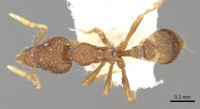Strumigenys cincinnata
| Strumigenys cincinnata | |
|---|---|

| |
| Scientific classification | |
| Kingdom: | Animalia |
| Phylum: | Arthropoda |
| Class: | Insecta |
| Order: | Hymenoptera |
| Family: | Formicidae |
| Subfamily: | Myrmicinae |
| Tribe: | Attini |
| Genus: | Strumigenys |
| Species: | S. cincinnata |
| Binomial name | |
| Strumigenys cincinnata (Kempf, 1975) | |
One of the few specimens of this species was collected from a forest with rocky soil.
Identification
Bolton (2000) - A member of the Strumigenys hyphata-group. This small species is closely related to Strumigenys hyphata but the two are immediately isolated by their unique clypeal pilosities.
Keys including this Species
Distribution
Latitudinal Distribution Pattern
Latitudinal Range: 9.15° to -3.10194°.
| North Temperate |
North Subtropical |
Tropical | South Subtropical |
South Temperate |
- Source: AntMaps
Distribution based on Regional Taxon Lists
Neotropical Region: Brazil (type locality).
Distribution based on AntMaps
Distribution based on AntWeb specimens
Check data from AntWeb
Countries Occupied
| Number of countries occupied by this species based on AntWiki Regional Taxon Lists. In general, fewer countries occupied indicates a narrower range, while more countries indicates a more widespread species. |

|
Estimated Abundance
| Relative abundance based on number of AntMaps records per species (this species within the purple bar). Fewer records (to the left) indicates a less abundant/encountered species while more records (to the right) indicates more abundant/encountered species. |

|
Biology
|
Castes
Nomenclature
The following information is derived from Barry Bolton's Online Catalogue of the Ants of the World.
- cincinnata. Smithistruma cincinnata Kempf, 1975a: 419, figs. 8-10 (w.) BRAZIL. Combination in Pyramica: Bolton, 1999: 1673; in Strumigenys: Baroni Urbani & De Andrade, 2007: 117. See also: Bolton, 2000: 198.
Unless otherwise noted the text for the remainder of this section is reported from the publication that includes the original description.
Description
Worker
Bolton (2000) - TL 1.6-1.8, HL 0.46-0.48, HW 0.30-0.32, CI 65-68, ML 0.07-0.08, MI 15-18, SL 0.20-0.22, SI 67-69, PW 0.19-0.21, AL 0.43-0.47 (3 measured).
Lateral margins of clypeus with a dense row of narrowly spatulate curved hairs that are directed anteriorly. Anterior clypeal margin with a row of 4-6 smaller spatulate hairs that project anteriorly and are curved downward . Dorsum of clypeus immediately behind anterior margin with a transverse row of erect spatulate short hairs that curve posteriorly and toward the midline. Posterior to this row the clypeal dorsum with a transverse row of 4 longer, apically thickened standing hairs that arch toward the midline; posterior to this, at the clypeal suture, with a transverse row of 4 even longer hairs that also curve medially. In addition the clypeal dorsum, immediately above the lateral marginal row of curved hairs, with one or two erect and medially curved hairs on each side. Upper scrobe margin with 3-4 freely laterally projecting flagellate hairs. Leading edge of scape with 4 long wire-like hairs that are hook-shaped or shaped like question-marks; basal three of these are hooked toward the base of the scape, the apical one is hooked toward its apex. All dorsal surfaces of head and body, from clypeus to postpetiole, reticulate-punctate.
Type Material
Bolton (2000) - Holotype worker, BRAZIL: Amazonas, km. 49 Manaus to Itacoatiara Rd, 24.viii.1962 (W.L. Brown); paratype workers, BRAZIL: AM , 20-25 km. N and NE of Manaus, viii-ix.1962 (W.L. Brown); AM, Ponte Negra, N of Manaus, i.ix.1962 (W.L. Brown) (Museum of Comparative Zoology, Museu de Zoologia da Universidade de Sao Paulo) [examined].
References
- Albuquerque, E., Prado, L., Andrade-Silva, J., Siqueira, E., Sampaio, K., Alves, D., Brandão, C., Andrade, P., Feitosa, R., Koch, E., Delabie, J., Fernandes, I., Baccaro, F., Souza, J., Almeida, R., Silva, R. 2021. Ants of the State of Pará, Brazil: a historical and comprehensive dataset of a key biodiversity hotspot in the Amazon Basin. Zootaxa 5001, 1–83 (doi:10.11646/zootaxa.5001.1.1).
- Baroni Urbani, C. & De Andrade, M.L. 2007. The ant tribe Dacetini: limits and constituent genera, with descriptions of new species. Annali del Museo Civico di Storia Naturale “G. Doria” 99:1-191.
- Bolton, B. 1999. Ant genera of the tribe Dacetonini (Hymenoptera: Formicidae). Journal of Natural History. 33:1639-1689. (page 1673, Combination in Pyramica)
- Bolton, B. 2000. The ant tribe Dacetini. Memoirs of the American Entomological Institute. 65:1-1028. (page 198, redescription of worker)
- Chaul, J.C.M. 2023. A new ant species of Strumigenys Smith, 1860 (Hymenoptera: Formicidae) from the Brazilian atlantic forest. Taxonomy 2023, 2, 221–231 (doi:10.3390/taxonomy3020016).
- Franco, W., Ladino, N., Delabie, J.H.C., Dejean, A., Orivel, J., Fichaux, M., Groc, S., Leponce, M., Feitosa, R.M. 2019. First checklist of the ants (Hymenoptera: Formicidae) of French Guiana. Zootaxa 4674, 509–543 (doi:10.11646/zootaxa.4674.5.2).
- Kempf, W. W. 1975a [1974]. Report on Neotropical Dacetine ant studies (Hymenoptera: Formicidae). Rev. Bras. Biol. 34: 411-424 (page 419, figs. 8-10 worker described)
References based on Global Ant Biodiversity Informatics
- Franco W., N. Ladino, J. H. C. Delabie, A. Dejean, J. Orivel, M. Fichaux, S. Groc, M. Leponce, and R. M. Feitosa. 2019. First checklist of the ants (Hymenoptera: Formicidae) of French Guiana. Zootaxa 4674(5): 509-543.
- Lapolla, J.S., T. Suman, J. Soso-Calvo and T.R. Schultz. 2006. Leaf litter ant diversity in Guyana. Biodiversity and Conservation 16:491510
- Silva T. S. R., and R. M. Feitosa. 2019. Using controlled vocabularies in anatomical terminology: A case study with Strumigenys (Hymenoptera: Formicidae). Arthropod Structure and Development 52: 1-26.
- Sosa-Calvo J., S. O. Shattuck, and T. R. Schultz. 2006. Dacetine ants of Panama: new records and description of a new species. Proceedings of the Entomological Society of Washington 108: 814-821.
- Sosa-Calvo J., T. R. Schultz, and J. S. LaPolla. 2010. A review of the dacetine ants of Guyana (Formicidae: Myrmicinae). Journal of Hymenoptera Research 19: 12-43.

